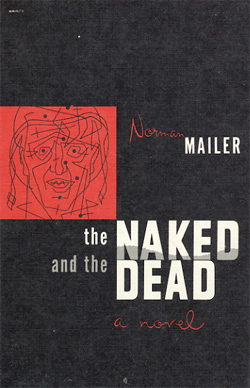“The Naked and the Dead is an enormously long novel, washed up by the choppy waters of disillusionment, leaving nothing to the imagination.” That’s what David Dempsey had to say in a review on the novel for The New York Times in 1948. Dempsey went on to say that The Naked and the Dead revealed a great new talent in American fiction, Norman Mailer, but that the book was “not great.” A half-century after the publication of The Naked and the Dead and two years after Mailer’s death, it’s clear that Dempsey was both right and wrong. He sniffed out the general talent, but whiffed on the specific work.
No matter. The special risk of criticism is to be wrong in print, wrong for eternity. It is hard to blame Mr. Dempsey. The Naked and the Dead was not written for him. It is a novel that had to wait another 20 years for the America it envisioned to come fully into view. The Boomers were the ones who discovered, in Vietnam, that national greatness takes a toll. They began to doubt themselves.
But that came later. The Greatest Generation was known for one thing, primarily. Certainty. Certainty of place, of purpose, of duty, and of destiny. I exaggerate, but not that much. They called World War II “The Good War.” Moral absolutism came cheap then. Who was going to argue with the boys who put down the Third Reich?
Mailer never argued. He just kept talking and showing, talking and showing. The Naked and The Dead begins in the sleepless terror of a military convoy en route to a beach landing and ends with the matter-of-fact murder of a Japanese prisoner with testicles so swollen he “had to cut away his trousers from his groin the way a man with a bunion slits the toe off an old shoe.”
It makes me think of Tolstoy, but not in the way you might think. It is not the epic scale of Tolstoy that impresses, but the minutiae of people thinking and acting. Look, for instance, at the way Tolstoy takes us through Anna’s suicide in Anna Karenina.
But she did not take her eyes from the wheels of the second car. And exactly at the moment when the space between the wheels came opposite her, she dropped the red bag, and drawing her head back into her shoulders, fell on her hands under the car, and lightly, as though she would rise again at once, dropped onto her knees. And at the same instant she was terror-stricken at what she was doing. “Where am I? What am I doing? What for?” She tried to get up, to drop backward; but something huge and merciless struck her on the head and drew along on her back. “Lord, forgive me all!” she said, feeling it impossible to struggle.
The essence of all human behavior is in those lines. Thought, action, doubt, terror, resolve, and then back again. It is willing something and then finding that the willing outpaces what you willed. Tolstoy’s genius is in being able to go through that process along with the characters he had created.
Mailer could do that, too. Here are a few sentences describing one of the American soldiers assigned to carry a wounded comrade back to camp:
Brown felt bitter. There was no way out of it. It seemed like a plot against them all. They were betrayed, that’s all. He could not have said who betrayed them, but the idea fed his bitterness, was fragilely pleasant.
I like the way the bitterness takes its course in those sentences. It is plain and simple at first. Then it expands. It goes from Brown to everyone else. The fault becomes all encompassing, nameless. And then, all of a sudden we hit the word “fragilely.” That is an ugly adjective. It is almost impossible to say. Fragilely. The mind comes to a halt before it. But so does the bitterness. He’s right though, Mailer is. The bitterness does become pleasant. Emotions turn into their opposites. Or we decide to do one thing and then find ourselves acting out something different.
The greatness of Tolstoy was in allowing those surprises to happen, loving them even, delighting in the way his characters could suddenly jump beyond their own author, making odd the narrative just as we make odd the world. Applying that same logic to WWII, Mailer forces us to stare at the pieces. His biographical sketches of the soldiers in one specific platoon deepen the picture not by clarifying motives or intentions, but by making each of the soldiers so real we don’t know how to judge them anymore. We just know them. WWII was fought by millions of human beings, any one of which, on both sides, was knowable in exactly the same way. We didn’t like to think about that much in 1948, nor did we in 1968, nor do we today. But it’s the truth. • 16 September 2009




